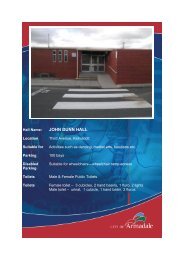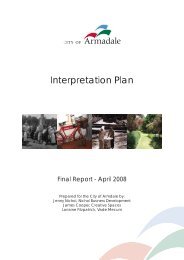Public Toilet Strategy 2013 - City of Armadale
Public Toilet Strategy 2013 - City of Armadale
Public Toilet Strategy 2013 - City of Armadale
Create successful ePaper yourself
Turn your PDF publications into a flip-book with our unique Google optimized e-Paper software.
APPENDIX 1 – DESIGN GUIDELINES<br />
The <strong>City</strong> <strong>of</strong> <strong>Armadale</strong> should use the following design elements for the upgrading and provision <strong>of</strong> all future<br />
public toilet facilities:<br />
1. APPLICATION OF CRIME PREVENTION THROUGH ENVIRONMENTAL<br />
DESIGN (CPTED) PRINCIPLES.<br />
One <strong>of</strong> the major challenges for the <strong>City</strong> in providing public toilet facilities is to strike a balance between<br />
security and practicality on the one hand and aesthetics on the other. Too much security promotes a fortress<br />
mentality. Environmental design must reduce criminal activity while maintaining aesthetic standards sought<br />
by architects.<br />
CPTED is a multi-disciplinary approach to deterring criminal behavior through environmental design. CPTED<br />
strategies rely upon the ability to influence <strong>of</strong>fender decisions that precede criminal acts.<br />
In terms <strong>of</strong> effectiveness, a more accurate title for the strategy would be crime deterrence through<br />
environmental design. Research demonstrates that <strong>of</strong>fenders cannot be literally prevented from committing<br />
crimes by using CPTED, as it relies upon changes to the physical environment that will cause an <strong>of</strong>fender to<br />
make certain behavioral decisions. Those changes are crafted so as to encourage behavior, and thus they<br />
deter rather than conclusively "prevent" behavior.<br />
Beyond the attraction <strong>of</strong> being cost effective in lowering the incidence <strong>of</strong> crime, CPTED typically reduces the<br />
overall costs <strong>of</strong> preventing crime. Retr<strong>of</strong>itting an existing public toilet to meet CPTED can sometimes be<br />
costly, but when incorporated in the original design phase <strong>of</strong> facility planning, cost <strong>of</strong> designing to CPTED<br />
principles are <strong>of</strong>ten lower than with traditional approaches. Operational costs are <strong>of</strong>ten lower also, as CPTED<br />
lighting designs can significantly lower energy use. Also adding to the attraction <strong>of</strong> CPTED principles to the<br />
provisions <strong>of</strong> public toilets is that it lowers liability.<br />
This can also be achieved by Natural surveillance: in which residents or adjacent landowners/shopkeepers<br />
casually observe and monitor public toilets in their environment and intercept those who do not belong.<br />
Practically, people must be able to see all the non-private parts <strong>of</strong> the toilet facility if they are to help prevent<br />
crime.<br />
Many existing public toilets within the CoA were not designed with CPTED in mind and will require significant<br />
changes or even removal. Although modification might be expensive, it is recommended that the Design<br />
Guidelines, as outlined below, be taken into account when Council design or redesign public toilet facilities.<br />
2. LOCATION AND SITING<br />
<strong>Public</strong> toilets should only be located where the following criteria can be met:<br />
• High traffic and high pedestrian volume<br />
• Picnic and BBQ or site <strong>of</strong> frequent public/sporting activity<br />
• Opposite or adjacent to a building that provides the opportunity for casual surveillance<br />
• Clearly visible from all or most directions<br />
• As close as practicable to streets, footpaths and car parking areas<br />
• On sites with the capacity/necessary services to handle the effluent.<br />
Page<br />
41

















